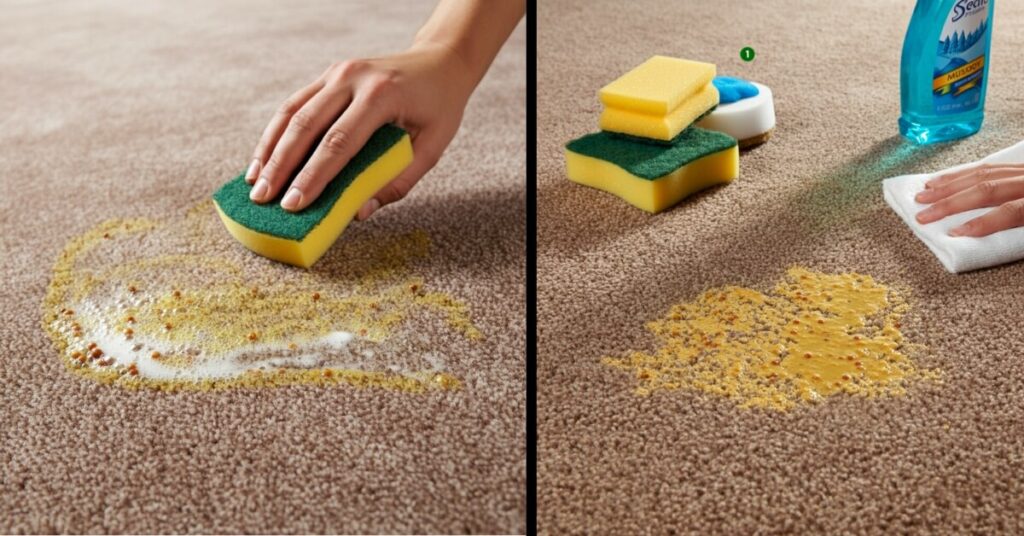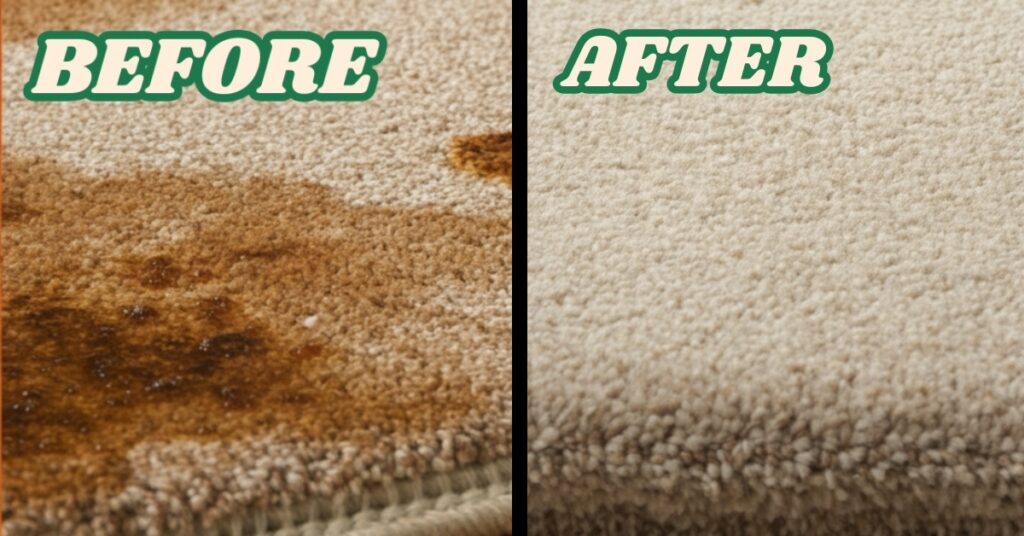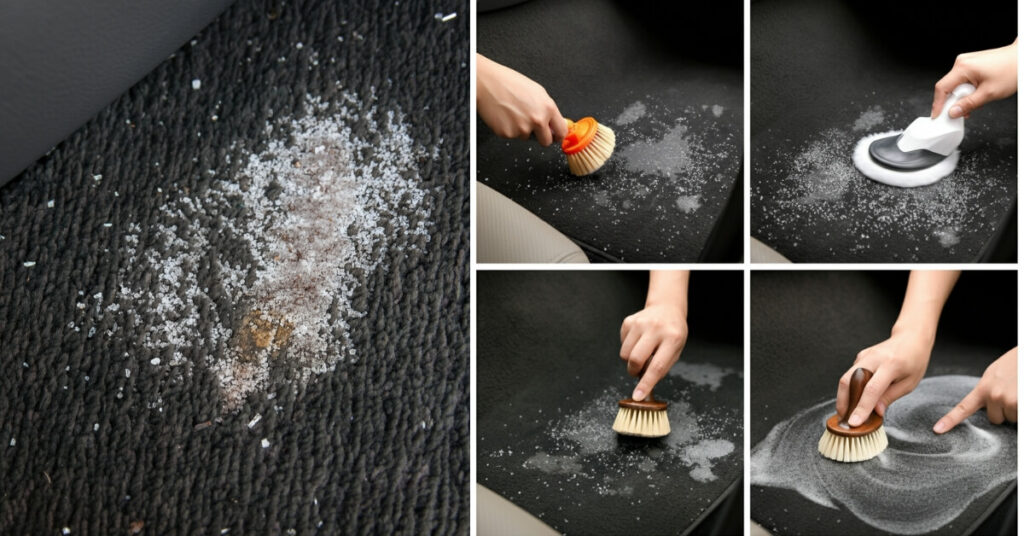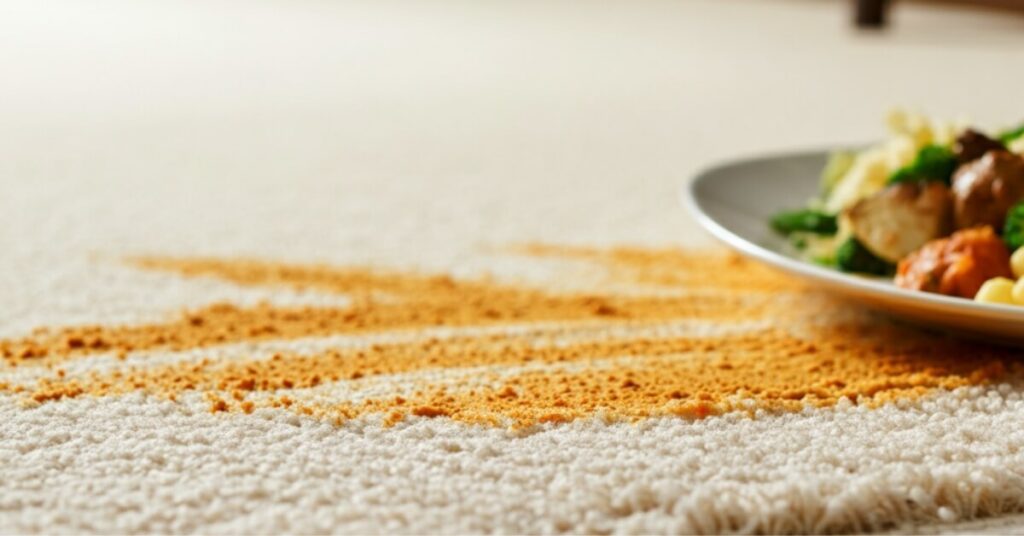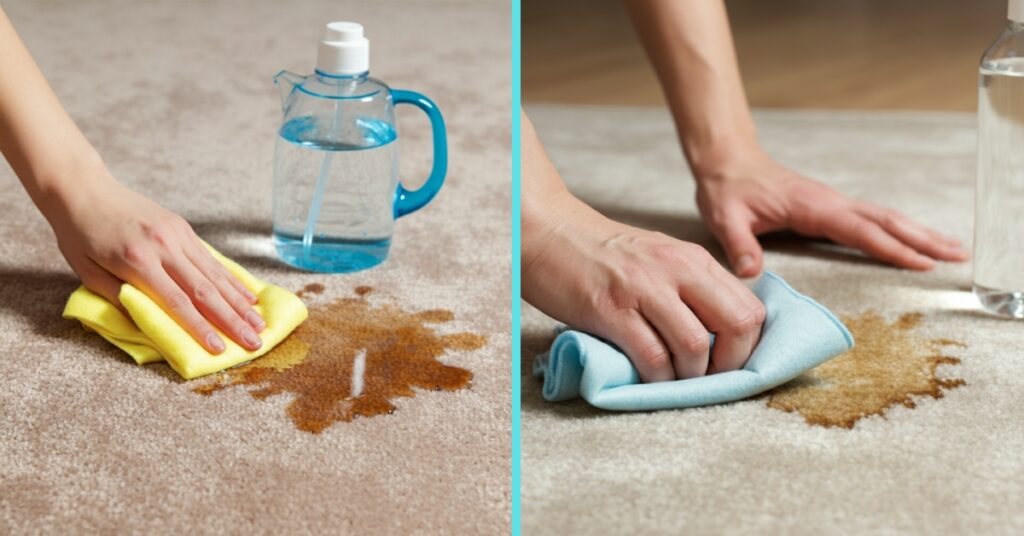As an Amazon Associate, I earn from qualifying purchases.
Although seemingly odd, mustard stains found on carpets are quite frequent. In addition to being common, these stains are tough to remove. This is primarily due to mustard’s vivid yellow color and turmeric’s bold yellow hues. If you’re wondering how to get mustard stain out of carpet, it’s essential to act quickly before the pigments set. Prompt attention and the right cleaning method can make a significant difference.
If you’ve had an unfortunate spill, you may ask yourself, “Can these stains really be removed?” The good news is yes! There are several methods to permanently eliminate the stain without having to rely on expensive professionals.
In this article, we will analyze all aspects concerning how to get mustard stains out of carpets, such as why mustard stains pose such a problem, detailed removal instructions, advanced techniques for older stains, and even proper methods for drying the carpet.
Contents Overview
Why Mustard Stains Are So Tough
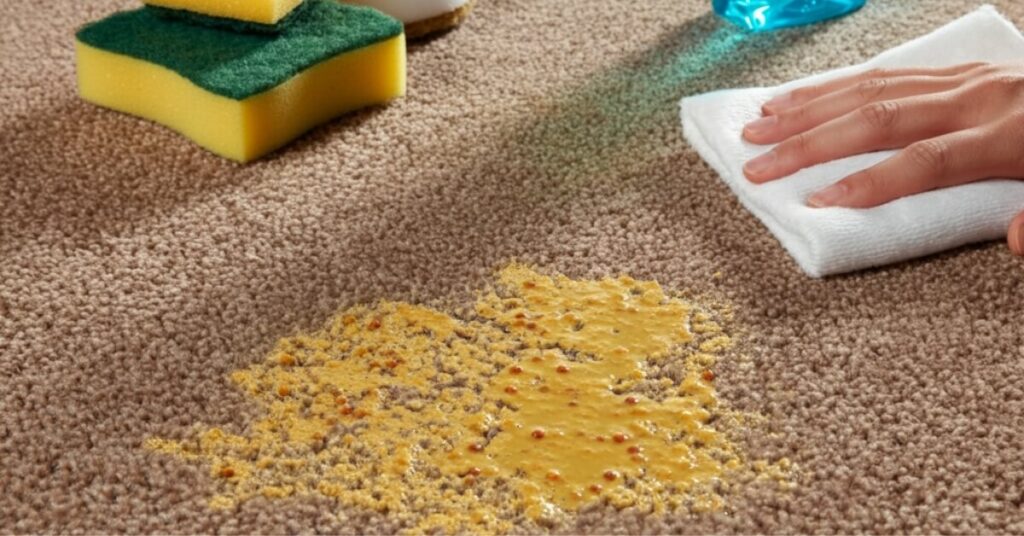
The science behind why mustard stains are one of the most difficult to remove is really interesting. Unlike a lot of food stains, the mustard contains powerful pigments and acids:
- Turmeric: This is the primary coloring agent in mustard, and it is responsible for the trademark yellow color. Turmeric acts like a dye that clings tightly to carpet fibers. On the plus side, it does have small enough molecules that allow deep cleaning to reach the pile of carpet.
- Acid Content: As we know, mustard is acidic, and the acid content of mustard can also set stains faster by reacting with carpet synthetic fibers.
- Time Factor: The longer you wait to clean up mustard spills, the more pigments and the relevant acids have a chance to bind.
Because of the characteristics described above, ordinary cleaners do not completely remove stains but will instead lighten them or smear the stain around. To remove stubborn stains like mustard, it is best to target both the pigments and the acid effectively, while preserving your carpet’s lifespan.
Step-by-Step Guide: Eliminating Mustard Stains from Carpet
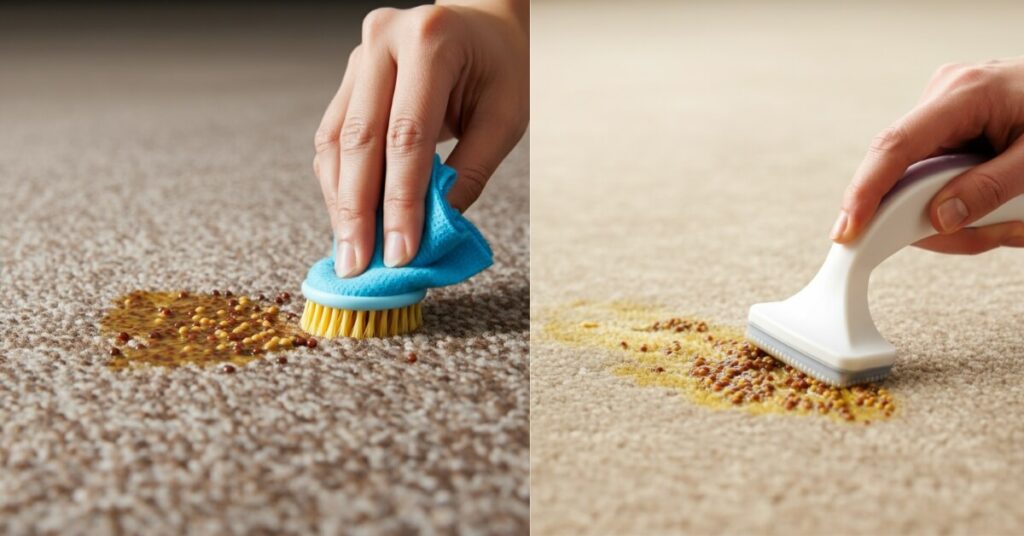
This guide provides straightforward tips to help you remove mustard stains from your carpet. Remember, speed is important, so gather everything in advance to clean efficiently.
Tools You’ll Need:
- A dull butter knife or spoon for scraping off stains
- Clean, white cloths or towels. Don’t use anything colored that’s fabric-textured, as it may be hard to remove.
- Clear and scent-free dishwashing liquid.
- White vinegar and baking soda can prove useful for older stains.
- Ammonia—for tough stains (always test first).
- Small mixing bowl and spray bottle.
Optional: Carpet cleaning brush, small carpet cleaner, and a high-speed fan.
Step 1: Eliminating Excess Mustard Stains
Grab a blunt knife or spoon and scrape off as much mustard as you can. Remember not to rub as it can make the stain worse.
Step 2: Blotting the Stain
Grab a clean white towel and try to absorb any liquid from the stain. Avoid the urge to rub and instead, focus on stepwise inwards. If the towel becomes wet, remember to use a fresh section or towel.
Step 3: Use Dish Soap Solution
One cup of warm water mixed with one teaspoon of mild dish soap creates a great solution for stains. Blot it onto the mark with a clean cloth, starting from the edges and moving inward. Do this two to three times, each time with fresh solution until the stain better.
Step 4: Use Vinegar Solution to Remove Yellow Tint
Pour equal parts of water and white vinegar into a spray bottle. Vinegar breaks down the turmeric dye, incorporating vinegar in water helps remove the yellow tint from the stain. Spray the mixture onto the stain and dab away with a clean cloth. If your stain appears mostly faded, you can stop treating it there. For persistent or older stains, continue reading.
How to Get Rid of Old or Stubborn Stains out of Carpet
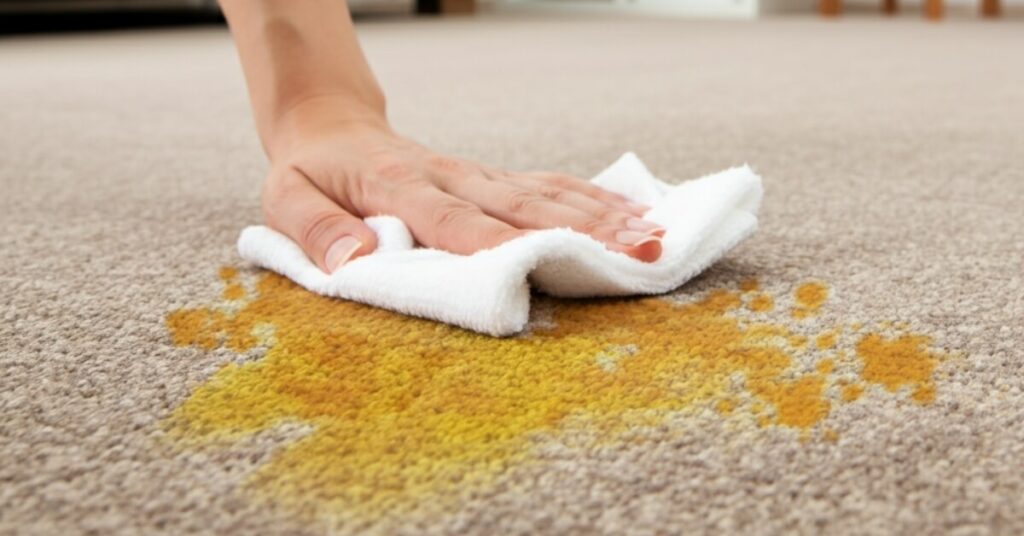
Deep dive into removing these older mustard stains with me.
Baking Soda and Vinegar
- Pour baking soda over the stain and saturate it until it has a good coating.
- Spray vinegar on there as well. It does fizz and bubble on the carpet. That removes the stain from the fibers.
- Let the mixture sit for around 10 to 15 minutes.
- To remove the paste, rinse the area with clean water, and blot dry.
Ammonia Solution (Caution!)
Although ammonia works well on set-in mustard stains, safety measures must be taken, such as wearing gloves and ensuring good ventilation. Never mix ammonia with bleach or other cleaners.
- Use half a cup of warm water to dissolve one tablespoon of clear ammonia.
- Check for any fading on your carpet by applying the solution on a less visible area.
- Blot the stain with a clean cloth dampened with the solution.
- Rinse the stain with clean water and blot dry.
Repeat the process or alternate between baking soda and ammonia for more stubborn, old stains.
Tips for Successful Drying
Drying is also very important for removing stains. Damp carpets can develop mildew and odors. For detailed guidance, check out our article on How to Dry Carpet After Cleaning.
- After cleaning, blot the area with a dry cloth.
- Speed up drying by placing a fan near the area or opening windows.
- To save you from bending over too much, a compact carpet cleaner or powerful fan is handy to have for all kinds of spills. Look for small carpet cleaners and fans for everyday and multifunctional use.
- Don’t step on the cleaned area until it’s dry to avoid trapping a thin layer of dirt and foot grime under the fibers.
What NOT to Do When Cleaning Mustard Stains
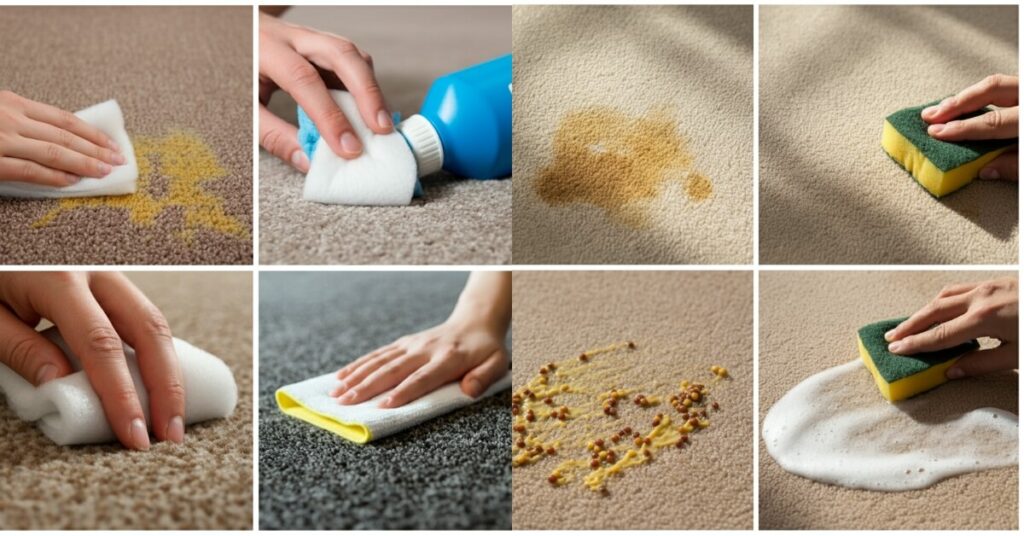
- Do Not Scrub: Scrubbing grinds the pigment deeper, making removal harder and possibly damaging the fibers.
- Avoid Hot Water on Fresh Stains: Hot water can “set” the stain, bonding the turmeric permanently.
- Never Mix Ammonia and Bleach: This releases dangerous fumes. Only use one chemical at a time—and always rinse the carpet between treatments.
- Don’t Use Colored Clothes: Dye from colored towels can transfer onto your carpet.
- Skip the Steam Cleaner—at least for initial treatment—since heat can set the stain.
Conclusion
Although mustard stains may look daunting, they don’t have to be the end of the world for your carpet. The carpet can be saved by gently scraping, blotting, and treating it, as long as those actions are done in the right order. Household items like vinegar and baking soda can be surprisingly effective for this task.
Using the techniques in this post not only protects your money but also your flooring investment. The right strategy, blended with proper speed and prevention, always leads to success.
Mustard Stain Removal FAQs
1. Will vinegar remove mustard from carpet?
Yes! Vinegar is especially powerful against turmeric-based stains because it helps break down the colored molecules. For best results, use vinegar in conjunction with dish soap or baking soda. Spray, blot, and repeat as needed.
2. Is bleach a good idea for mustard stains?
Absolutely not. Bleach may lighten your carpet but often sets the yellow further. It also weakens or destroys carpet fibers and can leave an unsightly residue.
3. What if a mustard stain remains after cleaning?
Don’t give up. Many stains fade after repeated treatment rather than disappearing right away. Switch between the above methods, or use a carpet stain remover for extra cleaning power. For extremely old or set-in stains, it may be worth calling a professional carpet cleaning service to avoid damaging your rug.
4. Are mustard stains permanent?
If mustard isn’t treated for hours or days, it can leave a permanent mark. However, with prompt action, modern cleaning solutions, and the right household products, most fresh spills can be removed entirely.
5. Is ammonia safe on carpet?
Ammonia is a useful cleaning agent for extreme stains, but it should be used with care. Always ventilate the room and wear gloves. Test on a hidden spot to make sure your carpet is colorfast. Never mix with bleach or any acid-based products.
6. How can I avoid re-soiling after treatment?
Keep off the treated area until completely dry. Use fans or a carpet dryer to speed the process. If you must use the space, lay a clean towel over the spot for protection.
As an Amazon Associate, I earn from qualifying purchases.
